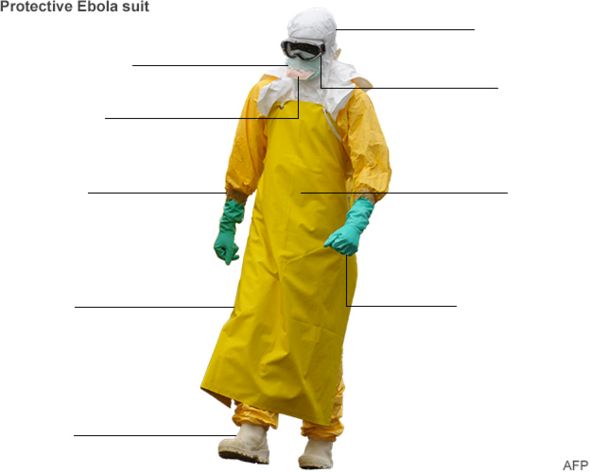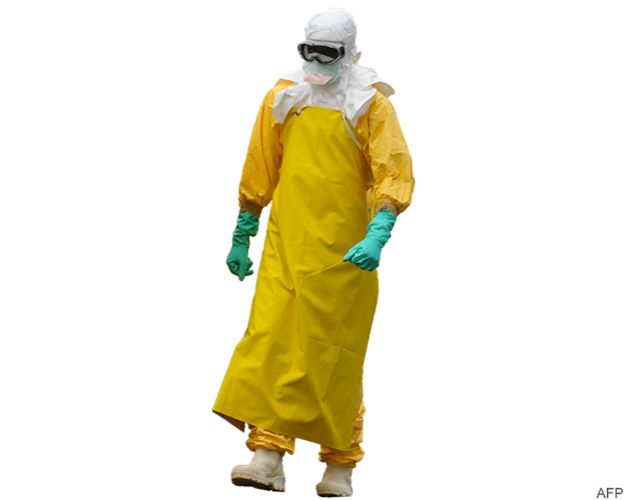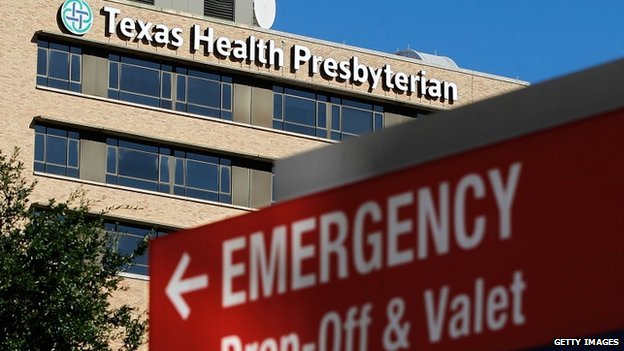Ebola outbreak: Second Texas health worker ‘tests positive’
 Both health workers treated Liberian national Thomas Duncan at the same hospital in Dallas
Both health workers treated Liberian national Thomas Duncan at the same hospital in DallasA second health worker in the US state of Texas has tested positive for Ebola, health officials say.
A 26-year-old female nurse is already receiving treatment after becoming infected by a Liberian man who died from the deadly virus last week.
Meanwhile, the UN’s Ebola mission chief says the world is falling behind in the race to contain the virus.
The World Health Organization (WHO) says 4,447 people have died from the outbreak, mainly in West Africa.
Sierra Leone, Liberia and Guinea have been hardest hit by the outbreak, which began in December 2013 but was confirmed in March.
 Residents of Freetown set up road blocks to demand the faster removal of bodies infected with EBola
Residents of Freetown set up road blocks to demand the faster removal of bodies infected with EBolaAnthony Banbury told a special session of the UN Security Council on Tuesday that if Ebola was not stopped now, the world would “face an entirely unprecedented situation for which we do not have a plan”.
President Barack Obama is due to hold a video conference with British, French, German and Italian leaders to discuss the Ebola crisis later on Wednesday.
In other developments:
- Liberia’s transport minister has gone into quarantine after her personal driver died from Ebola
- A football player for Sierra Leone’s national team says his team-mates have been stigmatised and humiliated by the Ebola outbreak
- The World Health Organization (WHO) warns the infection rate could reach 5,000 to 10,000 new cases a week in two months if efforts are not stepped up
New measuresNina Pham was exposed to Ebola at a Dallas hospital when she treated Liberian Thomas Duncan, the first person diagnosed with the virus on US soil.

Doctors at the Health Presbyterian hospital said she was in good condition on Tuesday.
The identity of the second health worker has not yet been revealed, however, the person also cared for Mr Duncan while he was in hospital.
 Mr Duncan, who is believed to have contracted the disease in Liberia, died on 8 October
Mr Duncan, who is believed to have contracted the disease in Liberia, died on 8 OctoberThe health worker was immediately isolated after reporting a fever on Tuesday, the Texas State Department for Health said in a statement.
“Health officials have interviewed the latest patient to quickly identify any contacts or potential exposures, and those people will be monitored,” the department said.
Naturally Cure Yeast Infections!
US officials previously said they were monitoring 48 contacts of the Liberian national and the healthcare workers who treated him.
The US Centers for Disease Control (CDC) expressed concern over the latest development in a statement, but added that it was “not unexpected that there would be additional exposures”.
It has announced new measures to improve hospital preparedness for Ebola treatment, including an immediate response team that will travel to the site of any future Ebola diagnoses to hit the ground “within hours”.
Nurses at the Dallas hospital say they worked for days without adequate protective clothing and received little guidance on how to prevent the spread of the virus.
Ebola patients treated outside West Africa*

*In all but three cases, first in Madrid and later in Dallas, the patient was infected with Ebola while in West Africa.
- Avoid direct contact with sick patients as the virus is spread through contaminated body fluids
- Wear goggles to protect eyes
- Clothing and clinical waste should be incinerated and any medical equipment that needs to be kept should be decontaminated
- People who recover from Ebola should abstain from sex or use condoms for three months
![]()
It comes after CDC chief Thomas Frieden said there had been a breach of protocol by health workers that led to the nurse becoming infected.
“The CDC is saying that protocols were breached, but the nurses are saying there were no protocols,” the head of the national nurses union, Roseann DeMoro, told reporters on Tuesday.
Mr Frieden later said he regretted not sending a larger team of experts to Texas when the first case of Ebola was diagnosed.
“We could’ve sent a more robust hospital infection control team and been more hands-on with the hospital from day one about exactly how this should be managed,” he said on Tuesday.
 Surgical cap
Surgical cap
Goggles
Medical mask
Scrubs
Overalls
Apron
Double gloves
Boots
Respirator
-
Protective Ebola suit

-
Surgical cap
The cap forms part of a protective hood covering the head and neck. It offers medical workers an added layer of protection, ensuring that they cannot touch any part of their face whilst in the treatment centre.
-
Goggles
Goggles, or eye visors, are used to provide cover to the eyes, protecting them from splashes. The goggles are sprayed with an anti-fogging solution before being worn.
-
Medical mask
Covers the mouth to protect from sprays of blood or body fluids from patients. When wearing a respirator, the medical worker must tear this outer mask to allow the respirator through.
-
Respirator
A respirator is worn to protect the wearer from a patient’s coughs. According to guidelines from the medical charity Medecins Sans Frontieres (MSF), the respirator should be put on second, right after donning the overalls.
-
Medical Scrubs
A surgical scrub suit, durable hospital clothing that absorbs liquid and is easily cleaned, is worn as a baselayer underneath the overalls. It is normally tucked into rubber boots to ensure no skin is exposed.
-
Overalls
The overalls are placed on top of the scrubs. These suits are similar to hazardous material (hazmat) suits worn in toxic environments. The team member supervising the process should check that the equipment is not damaged.
-
Double gloves
A minimum two sets of gloves are required, covering the suit cuff. When putting on the gloves, care must be taken to ensure that no skin is exposed and that they are worn in such a way that any fluid on the sleeve will run off the suit and glove. Medical workers must change gloves between patients, performing thorough hand hygiene before donning a new pair. Heavy duty gloves are used whenever workers need to handle infectious waste.
-
Apron
A waterproof apron is placed on top of the overalls as a final layer of protective clothing.
-
Boots
Ebola health workers typically wear rubber boots, with the scrubs tucked into the footwear. If boots are unavailable, workers must wear closed, puncture and fluid-resistant shoes.

